Table of Contents
Overview | Diagram | Scissors Bite | Reverse Scissors | Healthy Teeth | Q&A
Summary:
"Canine Teeth require the same type of care as human teeth including brushing and possibly straightening. Use this guide to learn about how to care for your dog's teeth."
Overview
The Dog Health Guide is one of the most complete resources for
understanding Canine Teeth. Here are some quick links to the site:
Normal Teeth
Normal Canine Bite
Canine
Tooth Brushing
Canine
Toothpaste
Info on
Puppy Teeth
Missing
Adult Teeth in Puppy
Canine
Gingivitis Remedies
Canine
Periodontal Disease
Canine
Halitosis
Canine
Bite Problems and Orthodonitia
Canine
Missing, Broken and Twisted Teeth
Caring for canine teeth is one of the fastest growing areas of dog
care with 5% of dogs getting some form dental care in their last visit
to the Veterinarian. Over 80% of dogs over 2 years old have some kind
of dental issue.
Periodontal disease is the most common disease in dogs and luckily is preventable and treatable. Like humans, brushing your dog’s teeth helps to avoid problems later on. See our section on Canine Tooth Brushing for advice on how to brush your dogs teeth. If you suspect that your dog has gingivitis or periodontal disease see our information on Canine Gingivitis Remedies. If you have a puppy, read this special section containing info on puppy teeth. Puppies grow teeth and loose them by the time they are age 7 months (also called deciduous teeth). Before you buy a puppy an x-ray can tell if the teeth are growing in correctly or if there is a genetic issue due to breeding.
If you believe there is something wrong with your dog's bite click on this link orthodontic treatment of impacted canine teeth.
Normal Canine Teeth
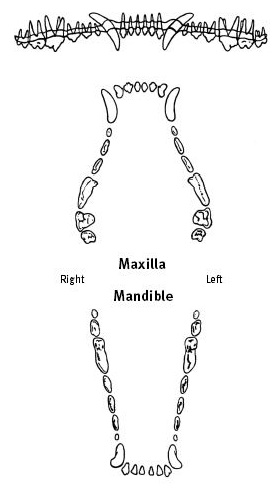
Breed clubs set their own standards for the number of teeth, which the AKC (American Kennel Club) approves. Puppies have 23 baby teeth. By the time your dog is an adult the average normal adult dog will have approximately 42 permanent teeth with 20 upper (maxilla) and 22 lower (mandible).
Each jaw has 6 incisors, 2 canines and 8 premolars.
In addition the lower jaw has 6 molars and the upper jaw has 4 molars.
The teeth on each side the lower jaw (mandible) start with 3 molars, 4 premolars, 1 canine and then the incisors (3 on each side).
The teeth on each side of the upper jaw (maxilla) start in the back with two molars, 4 premolars, 1 canine and then 3 incisors.
Missing teeth are usually in the premolar area.
Missing or extra teeth are considered a genetic defect, but usually doesn’t affect the health of the dog.
Collies and Doberman Pinchers are most often affected by extra or missing teeth and usually have less than the normal 8 premolars which tends not to be a problem for the dog.
Breeds with extra teeth include Greyhounds and the different spaniel breeds. Extra teeth that are crowding normal teeth need to be removed.
Canine Teeth and Age
You can tell the age of a dog by the wear on the incisor canine teeth (front teeth - reliable up to age 6).
Wear begins at age 1 with the caps getting worn off the lower incisors that are in the center of the front teeth. Tarter forms and then wear sets in on incisor 2 which is to the right and left of the two middle incisors. At age 5 the wear spreads to the next set of incisors which are to the right and left of the middle 4 teeth.
Normal Canine Bite
In normal dogs teeth are arranged “shoulder to shoulder” with no gaps allowing for food to naturally move from the teeth and gums . If there are gaps in the teeth or the teeth are aligned incorrectly, your dog could one day suffer pain or periodontal disease from the food that gets caught.
The type of bite your dog has depends on its breed. There are basically two kinds of bites in dogs: scissors bite and reverse scissors bite.
The Scissors Bite
Dogs with a scissors bite will have long length and narrow width muzzles or medium length and wide muzzles.
Long and Narrow Muzzle Breed Examples:
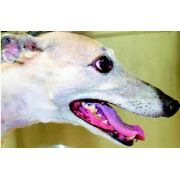
- Rough Collies
- Borzoi
- Doberman
- Greyhound
- Saluki
The upper incisors are located in front of the lower incisors when the mouth is closed, and there is a smooth curve from tooth to tooth if there are no missing or rotated teeth as shown below.
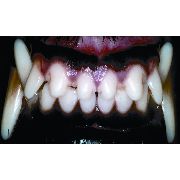 Canine Teeth that are Normal in Long Muzzle of Greyhound
Canine Teeth that are Normal in Long Muzzle of Greyhound(anterior view)
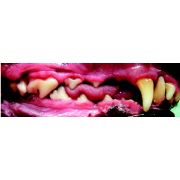 Long Muzzle Normal Dog Teeth in Buccal View
Long Muzzle Normal Dog Teeth in Buccal ViewDogs With Medium Muzzle Breed Examples:
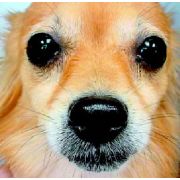
- Labrador Retriever
- German Shepherds
- Most Spaniels
- Terriers
- Hounds
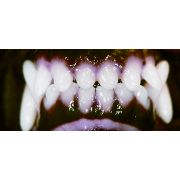 Normal Canine Teeth in Medium Muzzle Dog
Normal Canine Teeth in Medium Muzzle Dog(Anterior View)
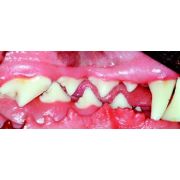 Normal Canine Teeth in Medium Muzzle Dog
Normal Canine Teeth in Medium Muzzle Dog(Buccal View)
Reverse Scissors Bite
In dogs with a short wide muzzle, a reverse scissor bite is considered normal where the lower incisors are in front of the upper incisors. The lower canines and premolars will be shifted forward. Sometimes this bite caused the dog to have pain from trauma to the lower jaw tissues.
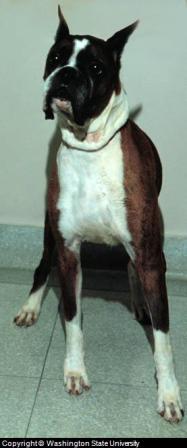
Breeds with Short and Wide Muzzles:
- Bulldog
- Pug
- Pekingese
- Boxer
- Boston Terrier
- Shih Tzu
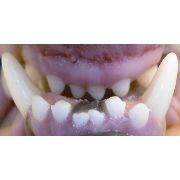 Normal Short Muzzle Canine Teeth
Normal Short Muzzle Canine Teeth(Anterior View)
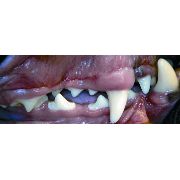 Normal Short Muzzle Dog Teeth
Normal Short Muzzle Dog Teeth(Buccal View)
Promoting Dental Health
There are several things you can do to help your dog maintain good dental health:
- Brush Your Dog's Teeth - Brushing your dog's teeth is just as important as brushing human teeth. This is done the same way but using a brush designed for use with dogs such as a finger brush and special toothpaste such as Four Paws Pet Dental Finger Toothbrush and Toothpaste.
- Dry Dog Food - Use a dry dog food that promotes good dental health such as Hill's Science Diet Oral Care Adult Dog Food. Chewing dry dog food has the abrasion against the teeth necessary to remove plaque.
- OraVet Plaque Prevention Gel ™ - Use of a dental sealant is becoming a standard recommendation by many veterinarians. The sealant forms a clear barrier over the teeth that in turn prevents plaque from forming.
- Dog Chews - Reward your dog with hard dog chews such as Greenies® Dental Treats. The abrasion on the teeth caused by chewing helps to remove plaque.
- Natural Supplements - Natural products such as Pet Alive Gums-n-Teeth helps to prevent gingivitis by combining herbal remedies known to promote healthy teeth and gums. These types of products are helpful for dog's that frequently accumulate plaque on their teeth.
Ask Our Vet A Question or Share Your Story
Have a Dog Dental Care related Question For Our Editors or A Story to Tell About This Topic?
Do you have a dog teeth, gums or dental care related question for our editors or a helpful story to share? Please include related information such as age, sex, breed, medical history, symptoms, diagnosis, diet, any pain, bleeding, changes in behavior,and medications.
We will do our best to get back to you quickly (depends on how many questions we receive each day). If you do require an immediate response we suggest using this online dog veterinary service that is available now.
In addition to specific therapies recommended by your veterinarian, consider adding a homeopathic product formulated to promote healthy teeth and gums such as Gumz-n-Teeth.
What Other Visitors Have Asked and Veterinarian Responses
Click below to see contributions from other visitors to this page...
Boxer Front Teeth Shortened 




My boxer's front teeth have shortened quite a bit. Could it be because he chews marrow bone? I give him marrow bone once or twice a week.
Vets tells …
Poodle with Dog Jaw Quiver or Chatter 




I have an 8 year old toy poodle. About 2 weeks ago I noticed that every time she would lick her mouth, regardless of food, her lower jaw would quiver. …
Are Dogs Affected Mentally when they Lose their Canines? Not rated yet
My rescued Pitt bull just had dental surgery and he used to bark, although never showed any aggression when he saw other dogs. Now since the canine teeth …
10 month old Wheaton Lost a Tooth Not rated yet
Our ten month old Wheaton just lost a lower canine. We think it is a molar but not sure -- it is in the centre of the right side bottom jaw. We can not …
Remove Baby Dog Teeth When Neutered Not rated yet
My five month old chihuahua puppy has his permanent teeth in the front, and he hasn't lost his baby teeth. I'm not sure if this is ok or what I should …
